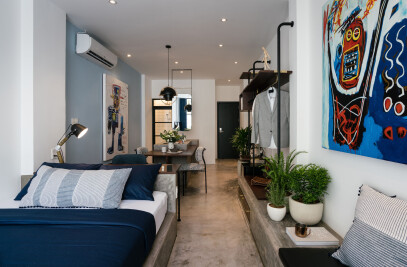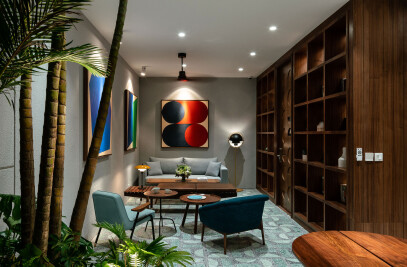Nestled amongst the narrow buildings and tall tube houses of District 1 in the typical urban form of Saigon, this 40-meter square renovated facility stands strong and high. Earlier serving the purpose of residential, this building is now converted to a facility for accommodation service businesses. Noteworthy of its extravagant scale and height – the building features some of the remarkable elements of the outdoor plantation, sleek geometry, and utter juxtaposition of materials.

The building stands five floors high – with the first floor serving the function of internal offices whereas the remaining four floors offering comfortable studio apartment spaces. One of the major challenges involved during the planning was the plot sizes being extremely narrow and small. The two major sides of the plot offer great views of the surrounding panorama allowing the building to expose its two facades.

However, the front façade allowed little privacy due to the close connection to the opposite house. So, the major opportunity laid was the back offering a view of the open sky of both the Hoa Lu Stadium and the city center. Based on both these positive and negative features, the design introduces a new layout plan that can use the space more effectively – moving the existing staircases from the back to the front of the house and exposing two facades to maximize natural light and ventilation.

Additionally, to further provide privacy to the rooms – they were offered a view at the backside of the building. The amalgamation of glass and brick is used for the purpose of allowing ample natural light to enter the bathroom and the space transition layer of the staircase, which is located right behind the iron partitions to help lighten the volume of the façade. On the façade, the white paint color is chosen to reflect the natural light while reducing the heat radiation.

After realizing the modest area of the house, it was important to add more plants and vegetation on the floor plan to necessarily cool down the living space and soften the concrete structure. Hence, a bright vertical garden was proposed that would filter out any dust and noise. Behind the green elements is a layer of iron partition with a space that allows light and wind to enter the house – offering an airy aura, both inside and out.

When entering the room, the eyes are met with a charming and comfortable interior space, with majestic views of the outdoors. The studio apartment presents two types of rooms with two different layouts and décor arrangements. The two extremes of light and dark colors of each room make a difference in the perception of the viewer. The room with brighter colors brings a feeling of coolness and open space. Whereas the room with darker colors is attractive, pushing the eyes’ focus to the majestic views through the windows to create a tranquil and relaxing space.

All of the furniture is a perfect combination of iron and ash wood, coated with a matte paint to reveal the original wood grain. The large columns of the old structure have been cleverly hidden with patrons oblivious to its presence in the room. The bathrooms were given utmost attention with flourishing natural light through the glass-brick wall. The mosaic tile is intended to hide the connecting wall corners, deceiving the eyes to make space appear larger and wider. In this room which is less than 25 square meters, we visualize an interesting space context that evoke emotions and increases user experience – especially important when designing for the hospitality industry.

This is also how architecture correlates with its surroundings and its context to the city. Meaningful architecture helps compensate for the lack of freshness in the city while offering a sense of presence and wellness. Therefore, even though the building is hidden inside the alley and is not fully visible, the architectural block will always be recognized by the green and friendly coloring.























































